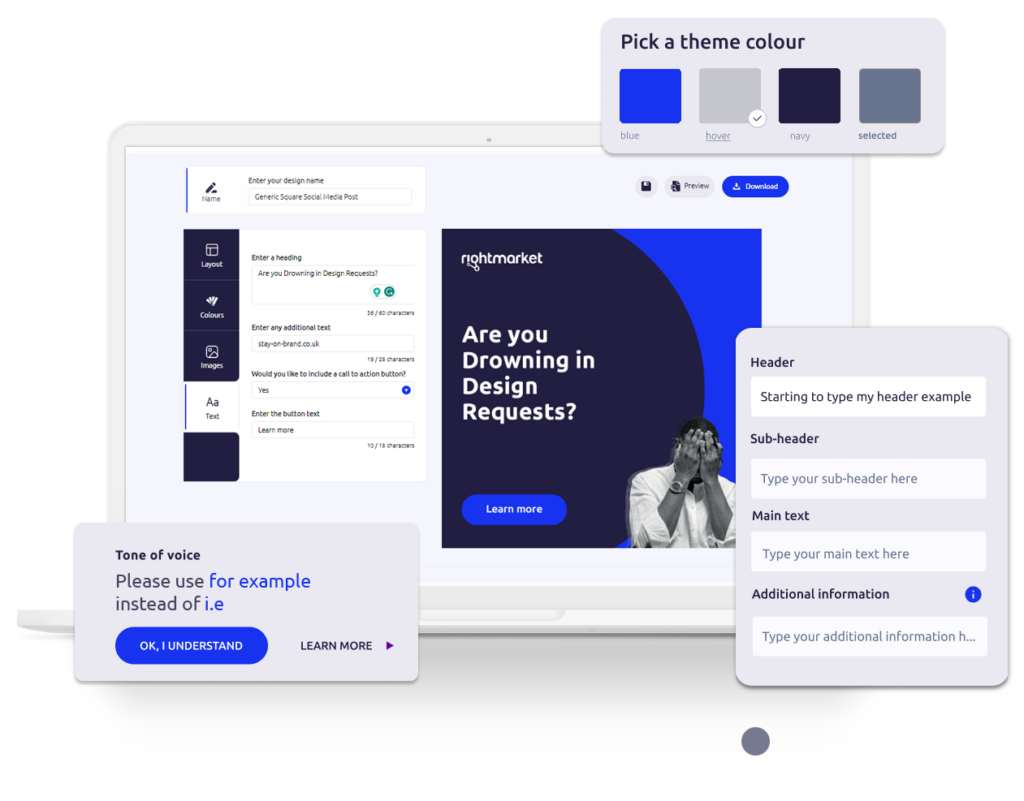How to increase brand awareness: A guide for marketing professionals
Key takeaways
- The foundation of loyalty: Brand awareness is critical in cultivating consumer loyalty and encouraging repeat purchases
- Standing out creatively: Employ innovative brand awareness ideas to distinguish your brand in a competitive market
- The power of social media: Utilise social media as a key tool to create and amplify brand awareness
- Brand recognition and consumer preference: Effective brand recognition leads to increased consumer preference and enhances brand equity
- Aligning goals and strategies: Integrating brand awareness objectives with overall marketing strategies is vital for business success
- Engaging with innovation: Developing fresh and innovative brand awareness campaign ideas is key to keeping consumer engagement vibrant
Navigating the journey to amplify your brand’s presence is both an art and a science. In this ever-evolving digital landscape, understanding and employing creative ways to enhance brand awareness is crucial. Our goal here is simple: to guide you through innovative strategies, making your brand a preferred choice among consumers.
In this article, we dive into the nuances of brand awareness in our fast-paced world, blending creativity with strategic thinking. Whether it’s leveraging social media’s vast potential or crafting impactful campaigns, we’re here to help demystify these processes.
We believe in simplifying complex ideas, ensuring you walk away with practical, actionable knowledge to make your brand both authentic and unforgettable.
The question of “how to create brand awareness effectively?” often leads businesses to explore diverse avenues like unique content, strategic partnerships, and consistent engagement across platforms.
It’s about weaving a story that enriches consumer perception and interaction with your brand, ultimately boosting recognition in a competitive marketplace.
Utilising digital tools for strategic gain
The digital era has revolutionised brand marketing, offering unparalleled opportunities to amplify your brand’s voice. As digital footprints become ubiquitous, securing a significant online presence is key to increasing brand awareness.
Embracing innovative digital tools within your marketing strategy isn’t just beneficial – it’s essential for staying ahead in today’s competitive landscape.
How senior marketers can leverage digital tools
For senior marketers, the digital toolkit opens a world of possibilities. It’s about curating content that strikes a chord with your audience, ensuring each digital interaction contributes positively to your brand’s growth. Let’s explore some impactful tools:
- Search engine optimisation (SEO): Position your brand at the top of search results
- Content marketing: Engage with informative blog posts and infographics
- Social media campaigns: Connect with audiences where they spend most of their time
- Email marketing: Foster direct, personalised communication with your audience
Each of these tools plays a vital role in crafting a compelling digital narrative for your brand, enhancing its visibility and presence in the consumer’s mind.
How brand management platforms integrate with marketing objectives
To harmonise complex marketing activities and maintain a consistent brand message, numerous organisations are embracing brand management platforms.

These systems serve as a central hub, fostering brand consistency. They streamline the creation and distribution of marketing materials by allowing non-marketing content creators to self-serve from on-brand templates, making coordinating campaigns more efficient and playing a pivotal role in boosting brand visibility and reputation.
| Brand management feature | Marketing objective alignment | Benefits |
|---|---|---|
| Templates and guidelines | Adherence to brand identity | Streamlines content creation |
| Workflow automation | Efficient campaign management | Reduces time-to-market |
| Performance analytics | Data-driven decision making | Insights for strategic optimisation |
| Asset repository | Consistency across channels | Unified brand messaging |
Implementing these brand management tools allows marketers to not only maintain oversight of their brand’s portrayal but also to utilise data and analytics for refining strategies—ultimately enhancing the impact of their brand across various digital platforms.
How Caremark used a RightMarket brand management platform to increase Brand Awareness
Caremark, a UK-based home care franchisor with over 115 offices, used RightMarket’s brand management platform to significantly enhance its local marketing strategies.
Previously, Caremark faced challenges due to a lack of consistent, aligned marketing across its branches, with only 10% having internal marketing capacity, leading to inconsistent branding and undermining customer trust.
RightMarket provided resources for creating on-brand marketing materials, ensuring brand consistency and empowering franchises to conduct effective local marketing. This included a Tone of Voice Assistant for modern, customer-friendly language, and customisable templates for various marketing assets.

The platform’s introduction led to a tenfold increase in Caremark’s marketing output, aligning local marketing efforts with national strategies and saving significant time for the marketing team.
Measuring impact and ROI
Grasping the essence of what brand awareness means in marketing is crucial for evaluating the effectiveness of marketing strategies. By meticulously analysing various metrics and key performance indicators (KPIs), businesses can gauge the success of their efforts to elevate their brand profile and widen their brand reach.
We’ll delve into the diverse methods used to assess these vital aspects of brand marketing.
Methods for measuring brand awareness
Measuring brand awareness goes beyond surface-level metrics, requiring a detailed examination of various factors that collectively reveal a brand’s impact on consumer awareness.
Essential methods include:
- Surveys: Assessing brand recall and recognition among target demographics.
- Website Traffic Analysis: Using direct website visits as a barometer for brand recall.
- Social Listening: Monitoring brand mentions and sentiment across various platforms.
- Engagement Metrics: Evaluating likes, shares, and comments to gauge brand interaction.
Techniques for quantifying the impact of brand awareness
Elevating brand visibility and recognition involves more than just increasing exposure; it requires understanding and influencing the emotional and cognitive connections people have with a brand.
Key strategies for achieving this deeper engagement include:
- Brand tracking studies: Monitoring changes in consumer perceptions over time.
- Sales data correlation: Linking sales figures with specific marketing campaigns to assess direct impact.
- Competitive share of voice analysis: Using analytics to compare brand prominence against industry competitors.
- Branded search monitoring: Observing increases in branded search queries as an indicator of growing consumer interest.
To better understand the relationship between these efforts and their results, an illustrative table can be used to provide clearer insights:
| Effort | Outcome | Measurement technique |
|---|---|---|
| Social media campaigns | Engagement and share of voice | Social listening and engagement tracking. |
| SEO and content marketing | Increase in organic traffic | Google Analytics to monitor traffic source and behaviour flow. |
| Brand partnership | New audience reach | Co-branding success metrics and cross-promotional analysis. |
| Awareness campaigns | Brand recall and recognition | Post-campaign consumer surveys and recall tests. |
By applying these techniques and analysing the resulting metrics, organisations can do more than just measure brand visibility and recognition. They can strategically enhance and refine their relationship with their audience.
Keeping a close watch on brand perception is crucial, as this understanding is key to fostering long-term growth and establishing a strong market position.
Addressing strategic challenges
In a time when capturing consumer attention is more challenging than ever, senior marketing professionals are recognising the importance of strategies that not only increase brand exposure but also enrich the brand’s overall image.
As the digital landscape and consumer behaviours evolve, crafting and maintaining a cohesive brand narrative becomes increasingly complex but even more essential for enhancing brand recognition.

Complex challenges faced by senior marketing professionals in enhancing brand awareness
Marketing leaders frequently face numerous challenges in improving brand recall. In a digital marketplace brimming with messages all vying for attention, it’s vital to identify and adopt innovative brand promotion techniques.
These techniques should resonate distinctly with the intended demographic, helping your brand stand out in a crowded digital landscape.
Strategic problem-solving and decision-making
Effective decision-making is pivotal in crafting campaigns that drive brand awareness. This requires a strategic, dynamic approach to problem-solving – one that involves understanding the brand’s core values and developing a distinctive brand personality that consumers can relate to and remember.
| Brand promotion technique | Potential impact | Considerations |
|---|---|---|
| Influencer collaborations | Amplifies reach and authenticity | Alignment with brand values and audience interests |
| Story-driven content | Boosts emotional connection and recall | Narrative consistency and relatability |
| User-generated content (UGC) | Enhances trust and community engagement | Encouragement of participation and sharing |
| Data-driven personalisation | Increased relevance and consumer satisfaction | Privacy considerations and data security |
| Interactive experiences | Creates memorable encounters and discussions | Accessibility and ease of use in different formats |
By embracing these methodologies, senior marketing professionals can look forward to cultivating a brand presence that not only exists within the market landscape but thrives within the consumers’ minds, ultimately reinforcing their decision to engage and advocate for the brand.
Future trends and strategic planning
Recognising and adapting to emerging trends is crucial for staying competitive.
As the future unfolds, the value of authenticity becomes increasingly prominent in shaping public perception.
Today’s brands are expected to offer more than just products; they need to resonate deeply with consumers by aligning with their values and narratives.
Marketers are tasked with crafting stories that position brands as not just commercial entities, but as vital, relatable elements in the everyday lives of their audiences.
Trends in brand marketing from a strategic and managerial perspective
The landscape of brand awareness is being transformed by digital innovation, especially through the use of data analytics and AI to understand consumer behaviour and personalise experiences.
Developing a unique brand voice using these advanced tools is becoming increasingly crucial for success.
Additionally, the rise of micro-influencers marks a shift towards grassroots marketing strategies.
These influencers, with their niche and highly engaged audiences, offer a more relatable touchpoint, significantly enhancing brand authority in specific communities.
Actionable insights for future planning and adaptation
In the evolving digital landscape, managers need to maintain an adaptable mindset.
Anticipating the effects of new technologies and platforms on customer interactions is key. With the dynamic nature of social media algorithms, agile content strategies that align with trending topics become essential, offering shareable and audience-relevant brand awareness content.
Achieving brand recognition involves being not just visible, but memorable. Focus on customer experience is vital, as positive interactions can transform consumers into brand advocates, naturally boosting brand awareness.
Find out how RightMarket can enhance your brand with Project Discovery.
Visit us to learn more about this value-driven service and how it can illuminate the path to greater brand efficiency and impact.
Let’s explore the possibilities together.
FAQs
How can you increase brand awareness?
Increasing brand awareness can be achieved through a variety of strategies, including social media marketing, content creation, SEO, influencer partnerships, engaging in brand storytelling, and running brand awareness campaigns focused on reaching a wider audience.
What are some innovative brand awareness campaign ideas?
Innovative brand awareness campaigns can include interactive content, leveraging emerging social media platforms, hosting virtual events, partnering with complementary brands, and creating unique, shareable experiences that resonate with the target audience.
How do senior marketers leverage digital tools to enhance brand visibility?
Senior marketers can leverage digital tools such as analytics to monitor brand performance, social media management platforms for content distribution, SEO tools for enhancing online presence, and customer relationship management (CRM) systems to personalise customer interactions and increase brand awareness.
How do brand management platforms integrate with marketing objectives?
Brand management platforms integrate with marketing objectives by providing a centralised system to maintain brand consistency, distribute assets, monitor brand usage, and measure the effectiveness of marketing strategies, ensuring that all marketing activities align with the overall brand awareness goals.
What methods are used for measuring brand awareness?
Brand awareness is measured using various methods, including surveys to assess brand recall and recognition, monitoring social media engagement and share of voice, analysing website traffic and search volume for branded terms, and tracking campaign performance metrics such as reach and impressions.
How can you quantify the impact of brand awareness?
The impact of brand awareness can be quantified by examining key performance indicators (KPIs) such as increases in customer acquisition, improvements in sales linked to awareness campaigns, the growth of social engagement metrics, and tracking the overall lift in market share.
What are the complex challenges faced by senior marketing professionals in enhancing brand awareness?
Senior marketing professionals face challenges like adapting to rapidly changing digital landscapes, maintaining brand relevance amongst a deluge of competitors, and ensuring that marketing efforts resonate with an increasingly discerning and fragmented audience.
What does strategic problem-solving and decision-making entail for enhancing brand awareness?
Strategic problem-solving and decision-making involve identifying the unique challenges of a brand, analysing target audience behaviour, using data-driven insights to guide marketing strategies, and being agile enough to adjust tactics in response to market feedback and emerging trends to enhance brand awareness.
What future trends should marketers consider for their strategic brand marketing plans?
Marketers should consider future trends such as the increased importance of authenticity and transparency, the leveraging of technology like augmented reality for interactive experiences, the utilisation of big data for targeted marketing, and the role of social responsibility in resonating with consumers’ values when planning their brand marketing strategies.
How can actionable insights be used for future planning and adaptation in brand marketing?
Actionable insights help inform future planning and adaptation by providing data on consumer behaviour, market trends, and campaign performance. These insights allow brands to make informed decisions, refine their messaging, optimise their marketing mix, and innovate their approach to stay ahead in the competitive landscape.